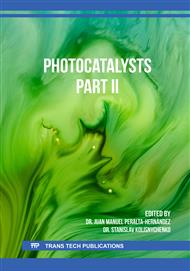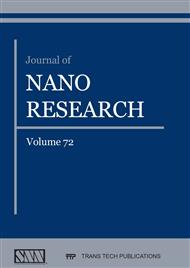[1]
Zazouli, M.A., et al., Study of natural organic matter fractions in water sources of Tehran. Pak J Biol Sci, 2007. 10(10): pp.1718-22.
Google Scholar
[2]
Zazouli, M.A. and L.R. Kalankesh, Removal of precursors and disinfection by-products (DBPs) by membrane filtration from water; a review. Journal of Environmental Health Science and Engineering, 2017. 15(1): p.25.
DOI: 10.1186/s40201-017-0285-z
Google Scholar
[3]
Hall, R.P., B. Van Koppen, and E. Van Houweling, The human right to water: the importance of domestic and productive water rights. Sci Eng Ethics, 2014. 20(4): pp.849-68.
DOI: 10.1007/s11948-013-9499-3
Google Scholar
[4]
Zazouli, M.A., et al., Influences of solution chemistry and polymeric natural organic matter on the removal of aquatic pharmaceutical residuals by nanofiltration. Water Research, 2009. 43(13): pp.3270-3280.
DOI: 10.1016/j.watres.2009.04.038
Google Scholar
[5]
Zazouli, M., S. Nasseri, and M. Ulbricht, Fouling effects of humic and alginic acids in nanofiltration and influence of solution composition. Desalination, 2010. 250: pp.688-692.
DOI: 10.1016/j.desal.2009.05.021
Google Scholar
[6]
He, P., et al., Removal of Copper (II) by Biochar Mediated by Dissolved Organic Matter. Scientific Reports, 2017. 7(1): p.7091.
Google Scholar
[7]
O'melia, C., W. Becker, and K.-K. Au, Removal of humic substances by coagulation. Water Science and Technology, 1999. 40(9): pp.47-54.
DOI: 10.2166/wst.1999.0440
Google Scholar
[8]
Zazouli, M.A., et al., Photocatalytic degradation of food dye by Fe3O4–TiO2 nanoparticles in presence of peroxymonosulfate: The effect of UV sources. Journal of Environmental Chemical Engineering, 2017. 5(3): pp.2459-2468.
DOI: 10.1016/j.jece.2017.04.037
Google Scholar
[9]
Veisi, F., et al., Photocatalytic degradation of furfural in aqueous solution by N-doped titanium dioxide nanoparticles. Environ Sci Pollut Res Int, 2016. 23(21): pp.21846-21860.
DOI: 10.1007/s11356-016-7199-7
Google Scholar
[10]
Zazouli, M.A., et al., Effect of Sunlight and Ultraviolet Radiation in the Titanium Dioxide (TiO2) Nanoparticles for Removal of Furfural from Water. Journal of Mazandaran University of Medical Sciences, 2013. 23(107): pp.126-138.
Google Scholar
[11]
Ebrahimzadeh, M., S. Mortazavi-Derazkola, and M. Zazouli, Eco-friendly green synthesis and characterization of novel Fe3O4/SiO2/Cu2O Ag nanocomposites using Crataegus pentagyna fruit extract for photocatalytic degradation of organic contaminants. Journal of Materials Science: Materials in Electronics, 2019. 30: pp.10994-11004.
DOI: 10.1007/s10854-019-01440-8
Google Scholar
[12]
Dadban Shahamat, Y., et al., Catalytic degradation of diclofenac from aqueous solutions using peroxymonosulfate activated by magnetic MWCNTs-CoFe3O4 nanoparticles. RSC Advances, 2019. 9(29): pp.16496-16508.
DOI: 10.1039/c9ra02757b
Google Scholar
[13]
Yang, K., et al., Application of graphene-based materials in water purification: from the nanoscale to specific devices. Environmental Science: Nano, 2018. 5(6): pp.1264-1297.
DOI: 10.1039/c8en00194d
Google Scholar
[14]
Azadmanjiri, J., et al., Graphene-supported 2D transition metal oxide heterostructures. Journal of Materials Chemistry A, 2018. 6(28): pp.13509-13537.
DOI: 10.1039/c8ta03404d
Google Scholar
[15]
Shaik, M.R., et al., Solvothermal Preparation and Electrochemical Characterization of Cubic ZrO2 Nanoparticles/Highly Reduced Graphene (HRG) based Nanocomposites. Materials, 2019. 12(5): p.711.
DOI: 10.3390/ma12050711
Google Scholar
[16]
Saroyan, H., G.Z. Kyzas, and E.A. Deliyanni, Effective Dye Degradation by Graphene Oxide Supported Manganese Oxide. Processes, 2019. 7(1): p.40.
DOI: 10.3390/pr7010040
Google Scholar
[17]
Mahlambi, M.M., C.J. Ngila, and B.B. Mamba, Recent developments in environmental photocatalytic degradation of organic pollutants: the case of titanium dioxide nanoparticles—a review. Journal of Nanomaterials, 2015. 2015: p.5.
DOI: 10.1155/2015/790173
Google Scholar
[18]
Katagi, T., Direct photolysis mechanism of pesticides in water. Journal of pesticide science, 2018. 43(2): pp.57-72.
DOI: 10.1584/jpestics.d17-081
Google Scholar
[19]
Wu, S.-Y., S.S.A. An, and J. Hulme, Current applications of graphene oxide in nanomedicine. International journal of nanomedicine, 2015. 10(Spec Iss): p.9.
Google Scholar
[20]
Singh, D.P., et al., Graphene oxide: An efficient material and recent approach for biotechnological and biomedical applications. Mater Sci Eng C Mater Biol Appl, 2018. 86: pp.173-197.
Google Scholar
[21]
Geim, A.K., Graphene: status and prospects. science, 2009. 324(5934): pp.1530-1534.
DOI: 10.1126/science.1158877
Google Scholar
[22]
Rawal, S.B., et al., Design of visible-light photocatalysts by coupling of narrow bandgap semiconductors and TiO2: effect of their relative energy band positions on the photocatalytic efficiency. Catalysis Science & Technology, 2013. 3(7): pp.1822-1830.
DOI: 10.1039/c3cy00004d
Google Scholar
[23]
Irawaty, W., F.E. Soetaredjo, and A. Ayucitra, Understanding the Relationship between Organic Structure and Mineralization Rate of TiO2-mediated Photocatalysis. Procedia Chemistry, 2014. 9: pp.131-138.
DOI: 10.1016/j.proche.2014.05.016
Google Scholar
[24]
Tayel, A., A. Ramadan, and O. El Seoud, Titanium Dioxide/Graphene and Titanium Dioxide/Graphene Oxide Nanocomposites: Synthesis, Characterization and Photocatalytic Applications for Water Decontamination. Catalysts, 2018. 8(11): p.491.
DOI: 10.3390/catal8110491
Google Scholar
[25]
Liu, J., et al., Gold-loaded graphene oxide/PDPB composites for the synchronous removal of Cr(VI) and phenol. Chinese Journal of Catalysis, 2018. 39(1): pp.8-15.
DOI: 10.1016/s1872-2067(17)62933-4
Google Scholar
[26]
Luo, W., et al., Efficient removal of organic pollutants with magnetic nanoscaled BiFeO3 as a reusable heterogeneous Fenton-like catalyst. Environmental science & technology, 2010. 44(5): pp.1786-1791.
DOI: 10.1021/es903390g
Google Scholar
[27]
Mano, T., et al., Water treatment efficacy of various metal oxide semiconductors for photocatalytic ozonation under UV and visible light irradiation. Chemical Engineering Journal, 2015. 264: pp.221-229.
DOI: 10.1016/j.cej.2014.11.088
Google Scholar
[28]
COX, C. and S.S.Q. HEE, 1989 Annual Book of ASTM Standards: Water and Environmental Technology 1989 Annual Book of ASTM Standards: Water and Environmental Technology 11.01, 45-47, 1989. Journal of chromatography. B, Biomedical applications, 1996. 679(1): pp.85-90.
Google Scholar
[29]
Naeem, H., et al., Synthesis and characterization of graphene oxide sheets integrated with gold nanoparticles and their applications to adsorptive removal and catalytic reduction of water contaminants. RSC Advances, 2018. 8(7): pp.3599-3610.
DOI: 10.1039/c7ra12030c
Google Scholar
[30]
Fakour, H. and T.-F. Lin, Effect of humic acid on as redox transformation and kinetic adsorption onto iron oxide based adsorbent (IBA). International journal of environmental research and public health, 2014. 11(10): pp.10710-10736.
DOI: 10.3390/ijerph111010710
Google Scholar
[31]
Reza, K.M., A.S.W. Kurny, and F. Gulshan, Parameters affecting the photocatalytic degradation of dyes using TiO2: a review. Applied Water Science, 2017. 7(4): pp.1569-1578.
DOI: 10.1007/s13201-015-0367-y
Google Scholar
[32]
Zhang, J., et al., Photocatalysis: Fundamentals, Materials and Applications. Vol. 100. 2018: Springer.
Google Scholar
[33]
Azizi, A., et al., Adsorption performance of modified graphene oxide nanoparticles for the removal of toluene, ethylbenzene, and xylenes from aqueous solution. Desalination and Water Treatment, 2016. 57(59): pp.28806-28821.
DOI: 10.1080/19443994.2016.1193769
Google Scholar
[34]
Fagan, R., et al., A review of solar and visible light active TiO2 photocatalysis for treating bacteria, cyanotoxins and contaminants of emerging concern. Materials Science in Semiconductor Processing, 2016. 42: pp.2-14.
DOI: 10.1016/j.mssp.2015.07.052
Google Scholar
[35]
Ghaneian, M.T., et al., Humic acid degradation by the synthesized flower-like Ag/ZnO nanostructure as an efficient photocatalyst. Journal of Environmental Health Science and Engineering, 2014. 12(1): p.138.
DOI: 10.1186/s40201-014-0138-y
Google Scholar
[36]
Qamar, M., M. Saquib, and M. Muneer, Semiconductor-mediated photocatalytic degradation of anazo dye, chrysoidine Y in aqueous suspensions. Desalination, 2005. 171(2): pp.185-193.
DOI: 10.1016/j.desal.2004.04.005
Google Scholar
[37]
Singh, H., M. Muneer, and D. Bahnemann, Photocatalysed degradation of a herbicide derivative, bromacil, in aqueous suspensions of titanium dioxide. Photochemical & Photobiological Sciences, 2003. 2(2): pp.151-156.
DOI: 10.1039/b206918k
Google Scholar
[38]
de la Guardia, M. and S. Garrigues, Handbook of green analytical chemistry. 2012: Wiley Online Library.
Google Scholar
[39]
Argurio, P., et al., Photocatalytic Membranes in Photocatalytic Membrane Reactors. Processes, 2018. 6(9): p.162.
Google Scholar
[40]
Markad, G.B., et al., Metal free, carbon-TiO2 based composites for the visible light photocatalysis. Solar Energy, 2017. 144: pp.127-133.
DOI: 10.1016/j.solener.2016.12.025
Google Scholar
[41]
Chong, M.N., et al., Optimisation of an annular photoreactor process for degradation of Congo Red using a newly synthesized titania impregnated kaolinite nano-photocatalyst. Separation and Purification Technology, 2009. 67(3): pp.355-363.
DOI: 10.1016/j.seppur.2009.04.001
Google Scholar
[42]
Rehman, S., et al., Strategies of making TiO2 and ZnO visible light active. Journal of hazardous materials, 2009. 170(2-3): pp.560-569.
DOI: 10.1016/j.jhazmat.2009.05.064
Google Scholar
[43]
Rasalingam, S., R. Peng, and R.T. Koodali, Removal of hazardous pollutants from wastewaters: applications of TiO 2-SiO 2 mixed oxide materials. Journal of Nanomaterials, 2014. 2014: p.10.
DOI: 10.1155/2014/617405
Google Scholar
[44]
Palmer, F.L., B.R. Eggins, and H.M. Coleman, The effect of operational parameters on the photocatalytic degradation of humic acid. Journal of Photochemistry and Photobiology A: Chemistry, 2002. 148(1-3): pp.137-143.
DOI: 10.1016/s1010-6030(02)00083-7
Google Scholar
[45]
Yu, L., et al., Photocatalytic Degradation of Organic Dyes by H4SiW6Mo6O40/SiO2 Sensitized by H2O2. International Journal of Photoenergy, 2013. (2013).
Google Scholar
[46]
Jones, S.M. and E.I. Solomon, Electron transfer and reaction mechanism of laccases. Cellular and molecular life sciences, 2015. 72(5): pp.869-883.
DOI: 10.1007/s00018-014-1826-6
Google Scholar
[47]
Uyguner, C.S. and M. Bekbolet, A comparative study on the photocatalytic degradation of humic substances of various origins. Desalination, 2005. 176(1-3): pp.167-176.
DOI: 10.1016/j.desal.2004.11.006
Google Scholar
[48]
Johar, M.A., et al., Photocatalysis and bandgap engineering using ZnO nanocomposites. Advances in Materials Science and Engineering, 2015. (2015).
Google Scholar
[49]
Ola, O. and M.M. Maroto-Valer, Review of material design and reactor engineering on TiO2 photocatalysis for CO2 reduction. Journal of Photochemistry and Photobiology C: Photochemistry Reviews, 2015. 24: pp.16-42.
DOI: 10.1016/j.jphotochemrev.2015.06.001
Google Scholar
[50]
Gnanaprakasam, A., V. Sivakumar, and M. Thirumarimurugan, Influencing parameters in the photocatalytic degradation of organic effluent via nanometal oxide catalyst: a review. Indian Journal of Materials Science, 2015. (2015).
DOI: 10.1155/2015/601827
Google Scholar
[51]
Singh, D.K., et al., Kinetic, isotherm and thermodynamic studies of adsorption behaviour of CNT/CuO nanocomposite for the removal of As(iii) and As(v) from water. RSC Advances, 2016. 6(2): pp.1218-1230.
DOI: 10.1039/c5ra20601d
Google Scholar
[52]
Kumar, K.V., et al., Characterization of the adsorption site energies and heterogeneous surfaces of porous materials. Journal of Materials Chemistry A, 2019. 7(17): pp.10104-10137.
Google Scholar
[53]
Bahrami, M., M.J. Amiri, and S. Koochaki, Removal of caffeine from aqueous solution using multi-wall carbon nanotubes: kinetic, isotherm, and thermodynamics studies. Pollution, 2017. 3(4): pp.539-552.
Google Scholar
[54]
Barakat, M., et al., Photocatalytic degradation of 2-chlorophenol by Co-doped TiO2 nanoparticles. Applied Catalysis B: Environmental, 2005. 57(1): pp.23-30.
DOI: 10.1016/j.apcatb.2004.10.001
Google Scholar
[55]
Barakat, N.A., et al., Influence of temperature on the photodegradation process using Ag-doped TiO2 nanostructures: negative impact with the nanofibers. Journal of Molecular Catalysis A: Chemical, 2013. 366: pp.333-340.
DOI: 10.1016/j.molcata.2012.10.012
Google Scholar
[56]
Ahmad, J. and K. Majid, Enhanced visible light driven photocatalytic activity of CdO–graphene oxide heterostructures for the degradation of organic pollutants. New Journal of Chemistry, 2018. 42(5): pp.3246-3259.
DOI: 10.1039/c7nj03617e
Google Scholar
[57]
Zhao, D., et al., Enhanced photocatalytic degradation of methylene blue under visible irradiation on graphene@TiO2 dyade structure. Applied Catalysis B: Environmental, 2012. 111-112: pp.303-308.
DOI: 10.1016/j.apcatb.2011.10.012
Google Scholar
[58]
Zhang, Y., et al., Graphene TiO2 nanocomposites with high photocatalytic activity for the degradation of sodium pentachlorophenol. Journal of Environmental Sciences, 2014. 26(10): pp.2114-2122.
DOI: 10.1016/j.jes.2014.08.011
Google Scholar



